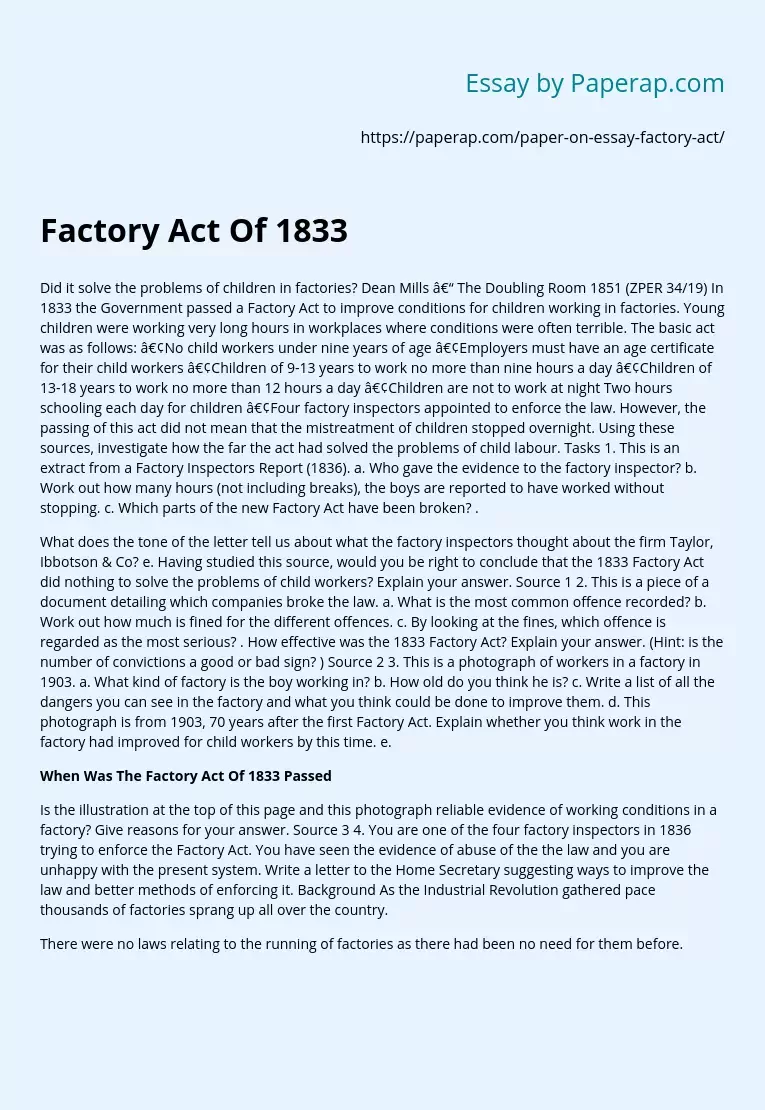Factory Act Of 1833
Did it solve the problems of children in factories? Dean Mills – The Doubling Room 1851 (ZPER 34/19) In 1833 the Government passed a Factory Act to improve conditions for children working in factories. Young children were working very long hours in workplaces where conditions were often terrible. The basic act was as follows: •No child workers under nine years of age •Employers must have an age certificate for their child workers •Children of 9-13 years to work no more than nine hours a day •Children of 13-18 years to work no more than 12 hours a day •Children are not to work at night Two hours schooling each day for children •Four factory inspectors appointed to enforce the law.
However, the passing of this act did not mean that the mistreatment of children stopped overnight. Using these sources, investigate how the far the act had solved the problems of child labour. Tasks 1. This is an extract from a Factory Inspectors Report (1836). a. Who gave the evidence to the factory inspector? b.
Work out how many hours (not including breaks), the boys are reported to have worked without stopping. c. Which parts of the new Factory Act have been broken? .
What does the tone of the letter tell us about what the factory inspectors thought about the firm Taylor, Ibbotson & Co? e. Having studied this source, would you be right to conclude that the 1833 Factory Act did nothing to solve the problems of child workers? Explain your answer. Source 1 2. This is a piece of a document detailing which companies broke the law.
a. What is the most common offence recorded? b. Work out how much is fined for the different offences. c. By looking at the fines, which offence is regarded as the most serious? . How effective was the 1833 Factory Act? Explain your answer. (Hint: is the number of convictions a good or bad sign? ) Source 2 3. This is a photograph of workers in a factory in 1903. a. What kind of factory is the boy working in? b. How old do you think he is? c. Write a list of all the dangers you can see in the factory and what you think could be done to improve them. d. This photograph is from 1903, 70 years after the first Factory Act. Explain whether you think work in the factory had improved for child workers by this time. e.
When Was The Factory Act Of 1833 Passed
Is the illustration at the top of this page and this photograph reliable evidence of working conditions in a factory? Give reasons for your answer. Source 3 4. You are one of the four factory inspectors in 1836 trying to enforce the Factory Act. You have seen the evidence of abuse of the the law and you are unhappy with the present system. Write a letter to the Home Secretary suggesting ways to improve the law and better methods of enforcing it. Background As the Industrial Revolution gathered pace thousands of factories sprang up all over the country.
There were no laws relating to the running of factories as there had been no need for them before. As a result, dangerous machinery was used that could, and frequently did, cause serious injuries to workers. To add to these dangers, people were required to work incredibly long hours – often through the night. Perhaps one of the worst features of this new industrial age was the use of child labour. Very young children worked extremely long hours and could be severely punished for any mistakes. Arriving late for work could lead to a large fine and possibly a beating.
Dozing at a machine could result in the accidental loss of a limb. People began to realise how bad these conditions were in many factories and started to campaign for improvements. There was a lot of resistance from factory owners who felt it would slow down the running of their factories and make their products more expensive. Many people also did not like the government interfering in their lives. Some parents, for instance, needed their children to go out to work from a young age, as they needed the money to help feed the family. Not all factory owners kept their workers in bad conditions however.
Robert Owen, who owned a cotton mill in Lanark, Scotland, built the village of New Lanark for his workers. Here they had access to schools, doctors and there was a house for each family who worked in his mills. By 1833, the Government passed what was to be the first of many acts dealing with working conditions and hours. At first, there was limited power to enforce these acts but as the century progressed the rules were enforced more strictly. Nonetheless, the hours and working conditions were still very tough by today’s standards, and no rules were in place to protect adult male workers.
Listed below are details of the legislation (laws) that was introduced to improve working conditions in factories. Date Industry Details of law 1833 Textiles No child workers under nine years Reduced hours for children 9-13 years Two hours schooling each day for children Four factory inspectors appointed 1844 Textiles Children 8-13 years could work six half-hours a day Reduced hours for women (12) and no night work 1847 Textiles Women and children under 18 years of age could not work more than ten hours a day. 1867 All Industries Previous rules applied to workhouses if more than five workers employed
Factory Act Of 1833. (2019, Dec 05). Retrieved from https://paperap.com/paper-on-essay-factory-act/

